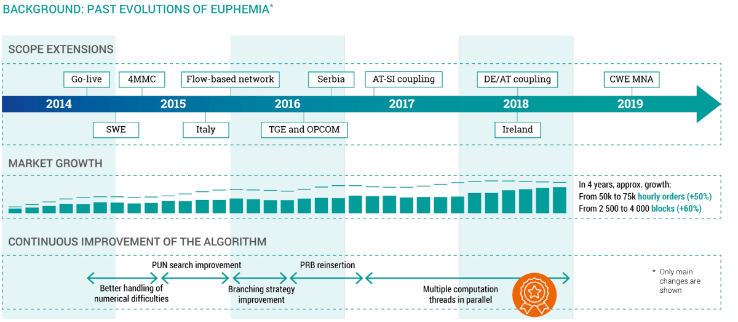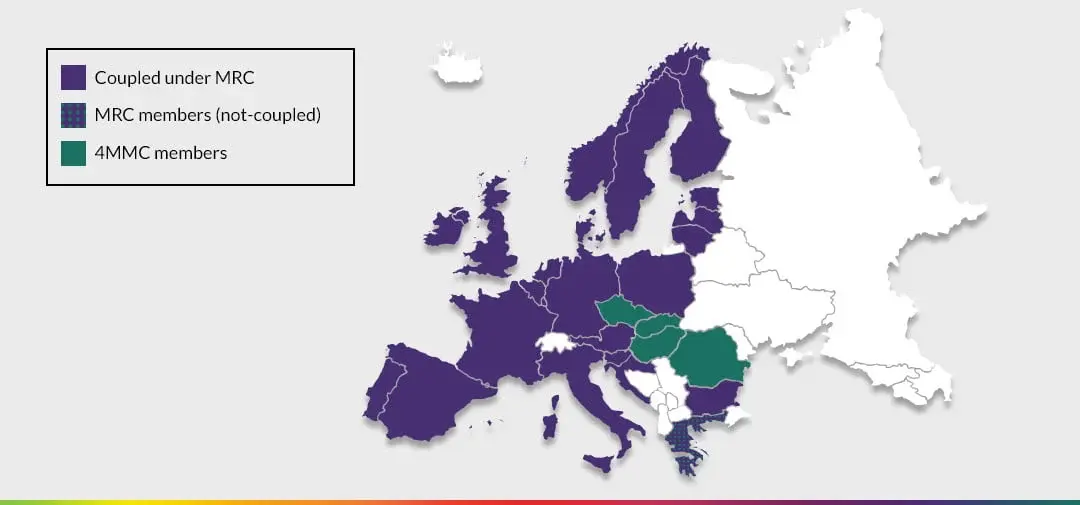Professional Services
Whether your challenge can be solved by our existing products or requires the development of new analytics solutions and market design approaches, our team is ready to help.
EUPHEMIA sets to clear the first Cross-border European Intraday Auction

-1.png)
 Jean Gillain
Jean Gillain
N-SIDE develops solutions for SIDC IDA with Euphemia
PCR EUPHEMIA, developed by N-SIDE, primarily known for clearing the Single Day-ahead Coupling (SDAC) European day-ahead market, is now extending its scope to include Single Intraday Coupling (SIDC) intraday auctions.
While SDAC aims to create a unified pan-European cross-zonal day-ahead electricity market—operating 12 to 36 hours in advance and enhancing trading efficiency, competition, liquidity —SIDC focuses on executing intraday auctions (IDAs) closer to real-time and during the day for pricing cross-border capacity and ensuring trading closer to real-time.
The integration of EUPHEMIA into SIDC enables to couple intraday cross-border exchanges and maximising social welfare for 25 countries. This is essential, because with the increase in renewable energies, it is becoming increasingly difficult to balance the market after the closure of the day-ahead market, while remaining economically efficient.
The Evolution of Europe's Intraday Market
Intraday markets in Europe have evolved significantly over the last few decades, driven by the need for more efficient electricity trading mechanisms following the liberalisation of the electricity market in the 1990s. These markets originally emerged to complement the Day-Ahead markets and address short-term imbalances between electricity supply and demand, which became more uncertain with the integration of renewable energy sources
Early Development with National Continuous Auctions
In the early 2000s, liberalisation efforts led to the establishment of initial intraday markets in various European countries, mainly through continuous auctions. These markets allowed traders to adjust their positions in real-time, providing the flexibility needed to balance supply and demand as renewable energy sources became more common. Continuous auctions enabled immediate transactions whenever matching bids were found, facilitating a dynamic and responsive trading environment.
Evolution to National Periodic Intraday Auctions
As the need for more structured and optimised trading increased, periodic intraday auctions were introduced at the end of the first decade of the 2000s: more information about the different trading options can be found in Table 1. These auctions operated in parallel with continuous auctions, increasing trading volumes and allowing traders to take more risk on the Day-Ahead and Forward markets. Periodic auctions allowed market participants to adjust their positions in the knowledge that liquidity was available on the intraday market. This development marked an important step in providing market participants with tools to manage short-term imbalances more effectively.

Table 1: Comparison of trading formats
The Launch of Cross-border continuous auctions
A major milestone came in 2018 with the introduction of SIDC via the XBID platform. This initiative initially connected 15 countries, enabling continuous cross-border trading and fostering competition. It also enhanced liquidity and provided greater flexibility for market participants to manage unforeseen changes in consumption and outages. The evolution of the SIDC members can be better understood by referring to Figure 2. Since 2022, the SIDC market has expanded to 25 countries, which are included in the current IDA market.

Evolution of Continuous auction members.
Source: NEMO Committee. (n.d.). Single Intraday Coupling (SIDC). Retrieved June 13, 2024, from https://www.nemo-committee.eu/sidc
Or source: ENTSO-E. (n.d.). Single Intraday Coupling (SIDC) Implementation. Retrieved June 13, 2024, from https://www.entsoe.eu/network_codes/cacm/implementation/sidc/
Start of cross-border intraday auctions
Intraday Auctions within the European Single Intraday Coupling system were introduced to effectively price the scarce cross-border capacities unattainable through continuous trading. Officially starting on June 13, 2024, IDAs were integrated into the market framework following the CACM regulation. This initiative improves competitive conditions by ensuring the efficient use of resources. It promotes economic efficiency and should increase the socio-economic welfare.
The Role, Impact, and Benefits of Intraday-Auction (IDA) in the European Energy Market
Operational time-line of SIDC Market
The Intraday Auctions enable cross-border electricity trading in over 25 countries. SIDC holds three daily auctions:
- IDA 1: For the full next day (00:00-24:00) with bids due by 15:00 on the preceding day (D-1).
- IDA 2: Also for the full next day, with bids due by 22:00 on D-1.
- IDA 3: For remaining hours of the current day (from 12:00 onwards), with bids due by 10:00 on the same day (D).
 Source: NEMO Committee. (2022, October 6). *SIDC IDA pre-launch event presentation*. Retrieved June 13, 2024, from https://www.nemo-committee.eu/assets/files/sidc-ida-pre-launch-event-presentation.pdf
Source: NEMO Committee. (2022, October 6). *SIDC IDA pre-launch event presentation*. Retrieved June 13, 2024, from https://www.nemo-committee.eu/assets/files/sidc-ida-pre-launch-event-presentation.pdf
The timing is tight because EUPHEMIA only has 7 minutes to find a solution that is close to maximising the welfare of all participants, and XBID has 20 minutes to submit the auction results after gate-closure.
Traders can also use the XBID platform for continuous trading outside IDA times. However, cross-zonal capacities are allocated exclusively by IDA auctions during IDA times and are not available for continuous trading during these times to prevent overlap and maintain trading efficiency.
Integrated EUPHEMIA features within IDA
In IDA, EUPHEMIA will make it possible to manage products by the hour, half-hour and quarter-hour. However, all products defined in the same bidding zone must be defined for the same time unit. The initial IDA model will be more simplistic than the day-ahead model because the network model will be ATC for the whole of Europe but should gradually evolve towards a flow-based like it is already the case for the day-ahead model. IDAs will not support PUNs (Prezzo Unico Nazionale), but will contain all the other orders available in the day-ahead market: curves, blocks, exclusive blocks, parent-child orders, and scalable complex orders for the Iberian Peninsula and Ireland.
Expected benefits from the Integration of IDAs
By adapting to the operational changes brought about by the IDA, traders should enjoy a series of benefits that promise to reshape the energy market landscape. With the introduction of three daily auctions, traders benefit from unprecedented flexibility and adaptability, enabling them to adjust their bids closer to real time, based on the results of Day-Ahead auctions and the capacity available on the market. This will enhance risk management capabilities, enabling market players to navigate dynamic market conditions with confidence.
Implementing the new IDAs in the intraday markets directly promotes the integration and utilization of renewables by providing market participants with enhanced flexibility in their bidding to manage fluctuations in renewable energy generation. This increased adaptability allows for more efficient scheduling and utilization of renewable resources.
The Future of Intraday Auctions
Increased liquidity in intraday markets should stimulate growth by enabling operators to make timely and economically viable decisions. More specifically, the SIDC market is about to introduce new features such as flow-based models and the expansion of 15-minute products, which are likely to improve market dynamics. This trend is not limited to Europe; it's worth noting that India recently inaugurated a new intraday market. We look forward to delving deeper into these developments in future blogs to provide comprehensive information and analysis.



About the Author
Jean has contributed to advancing European power market clearing through the Euphemia lab, supporting the transition to the 15-minute MTU in SDAC, and has been instrumental in helping launch N-SIDE's office in Japan. He holds a Master's in Applied Mathematics from UCLouvain, with a focus on optimization and machine learning for the energy sector, and has experience in robotic research prior to joining N-SIDE.
Jean Gillain




Other content like this one...

News
Single Day-Ahead Coupling important successes for the Euphemia Lab
The Euphemia Lab, providing cutting edge R&D services to bring PCR EUPHEMIA to the next level for the Single Day-ahead Coupling (SDAC) of European electricity...
Read more
News
Belgian algorithm determines Japanese electricity prices
日本語版はこちら Louvain-la-Neuve, Tokyo, 15 June 2023 - N-SIDE, a Belgian scale-up providing software and services for leading energy players to solve complex issues...
Read more
Blog
The Single Day-ahead Coupling (SDAC) and the PCR EUPHEMIA algorithm
The Single Day-ahead Coupling project sets a single pan-European day-ahead electricity market coupling today 26 European countries (Austria, Belgium, Czech...
Read more









